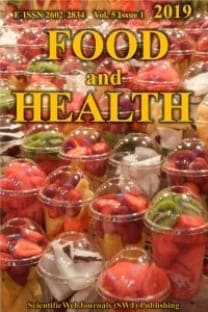PRELIMINARY STUDY OF DNA ЕXTRACTION FROM BULGARIAN HONEYS AND ITS AMPLIFICATION BY PCR FOR BOTANICAL IDENTIFICATION
The physiochemical and biological properties of honey are directly associated to its floral origin. Some current commonly used methods for identification of botanical origin of honey involve melissopalynological analysis or other analytical methods. However, these methods can be less sensitive and time-consuming. DNA-based methods have become popular due to their quickness and reliability. In this respect, the purpose on the present study is to compare two DNA extraction kits – DNeasy Plant Mini Kit (Qiagen) and GeneJET Genomic DNA Purification Mini Kit (Thermo Scientific) and CTAB method combined with different pre-treatment procedures and applied to 3 multifloral and 2 monofloral honey samples. The DNA extraction and amplification was carried out for all honey samples with similar results in each replication. The extracted DNA was amplified by PCR using plant specific primers rbcL gene and trnH-psbA spacer. The result obtained confirming that the DNA extracted has good quality for analysis of PCR products and that it can be used for botanical identification of honey.
___
Atanassova, J., Bozilova, E., Todorova, S. (2004). Pollen analysis of honey from the region of three villages in West Bulgaria. Phytologia Balcanica, 10(2-3), 247- 252.Atanassova, J., Kondova, V. (2004). Pollen and chemicalphysical analysis of unifloral honey from different regions of Bulgaria. Phytologia Balcanica, 10(1), 45-50.
Atanassova, J., Yurukova, L., & Lazarova, M. (2009). Palynological, physical, and chemical data on honey from the Kazanlak region (Central Bulgaria). Phytologia Balcanica, 15(1), 107-114.
Atanassova, J., Yurukova, L., Lazarova, M. (2012). Pollen and inorganic characteristics of Bulgarian unifloral honeys. Czech Journal of Food Sciences, 30(6), 520- 526.
Bruni, I., De Mattia, F., Martellos, S., Galimberti, A., Savadori, P. Casiraghi, M., Nimis, P.L., Labra, M. (2012). DNA Barcoding as an effective tool in improving a digital plant identification system: A case study for the area of Mt. Valerio, Trieste (NE Italy). PLoS ONE 7(9): e43256.
Bruni, I., Galimberti, A., Caridi, L., Scaccabarozzi, D., De Mattia, F. (2015). A DNA barcoding approach to identify plant species in multiflower honey. Food Chemistry, 170(1), 308-315.
Bulgarian State Standard (1980). Rules for sampling and tasting methods. Qualitative indicators on honey 3050- 80. http://www.bds-bg.org/bg/standard/?natstandard_document_id=61915 (accessed 18.10.2017)
Bulgarian State Standard (1980). Bee Honey 2673-80. De Mattia, F., Gentili, R., Bruni, I., Galimberti, A., Sgorbati S. (2012). A multi-marker DNA barcoding approach to save time and resources in vegetation surveys. Botanical Journal of the Linnean Society, 169, 518–529.
Fernandez-Torres, R., Pérez-Bernal, J., Bello-Lopez, M., Callejón-Mochón, M., Jimenez-Sanchez, J., GuiraumPerez, A. (2005). Mineral content and botanical origin of Spanish honeys. Talanta, 65, 686-691.
Galimberti, A., De Mattia, F., Bruni, I., Scaccabarozzi, D., Sandionigi, A., Barbuto, M., Casiraghi, M., Labra, M. (2014). A DNA barcoding approach to characterize pollen collected by honeybees. PLoS ONE 9(10): e109363.
Guyot, C., Scheirman, V., Collin, S. (1999). Floral origin markers of heather honeys: Calluna vulgaris and Erica arborea. Food Chemistry, 64, 3-11.
Hernandez, O.М., Fraga, J.M.G., Jiménez, A.I., Arias, J.J. (2005). Characterization of honey from the Canary Islands: Determination of the mineral content by atomic absorption spectrophotometry. Food Chemistry, 93, 449-458.
Lalhmangaihi, R., Ghatak, S., Laha, R., Gurusubramanian, G., Kumar, N. (2014). Protocol for optimal Quality and Quantity Pollen DNA isolation from Honey samples. Journal of Biomolecular Thechniques, 25, 92-95.
Latorre, M.J., Pena, R., Pita, C., Botana, A., Garcia, S., Herrero, C. (1999). Chemometric classification of honeys according to their type. II. Metal content data. Food Chemistry, 66, 263-268.
Liberato, M., Morais, S., Magalhaes, C., Magalhaes, I., Cavalcanti, D., Silva, M. (2013). Physicochemical properties and mineral and protein content of honey samples from Ceará State, Northeastern Brazil. Food Science and Technology (Campinas), 33(1), 38-46.
Longhi, S., Cristofori, A., Gatto, P., Cristofolini, F., Grando, M.S., Gottardini, Е. (2009). Biomolecular identification of allergenic pollen: A new perspective for aerobiological monitoring. Annals of Allergy, Asthma and Immunology, 103, 508-514.
Matsuki, Y.R., Tateno, R., Shibata, M., Isagi, Y. (2008). Pollination efficiencies of flowervisiting insects as determined by direct genetic analysis of pollen origin. American Journal of Botany, 95, 925-930.
Murray, H.G., Tompson, W.F. (1980). Rapid isolation of high molecular weight plant DNA. Nucleic acids Research, 8(19), 4321-4325.
Parducci, L., Matetovici, I., Fontana, S.L., Bennet, K.D.Y., Suyama, Y., Haile, J., Kurt, H., Kjaer, K.H., Larsen, N., Drouzas, A., Willerslev, E. (2012). Molecular and pollen-based vegetation analysis in lake sediments from Central Scandinavia. Molecular Ecology, 22, 3511- 3524.
Radovic, B.S., Careri, M., Mangia, A., Musci, M., Gerboles, M., Anklam, E. 2001. Contribution of dynamic head space GC–MS analysis of aroma compounds to authenticity testing of honey. Food Chemistry, 72, 511-520.
Soares, S., Amaral, J.S., Oliveira, M.B.P.P., Mafra, I. (2015). Improving DNA isolation from honey for the botanical origin identification. Food Control, 48, 130- 136.
Soria, A.C., Gonzalez, M., De Lorenzo, C., Martínez-Castro, I., Sanz, J. (2004). Characterization of artisanal honeys from Madrid (Central Spain) on the basis of their melissopaynological, physicochemical and volatile data. Food Chemistry, 85, 121-130.
Wang, J., Li, Q.X. (2011). Chemical composition, characterization, and differentiation of honey botanical and geographical origins. Advances in Food and Nutrition Research, 62, 89-137.
Wilson, E.E., Sidhu, C.S., Le Van, K.E., Holway, D.A. (2010). Pollen foraging behavior of solitary Hawaiian bees revealed through molecular pollen analysis. Molecular Ecology, 19, 4823-4829.
- ISSN: 2602-2834
- Yayın Aralığı: 4
- Başlangıç: 2018
- Yayıncı: ScientificWebJournals (SWJ) Özkan Özden
